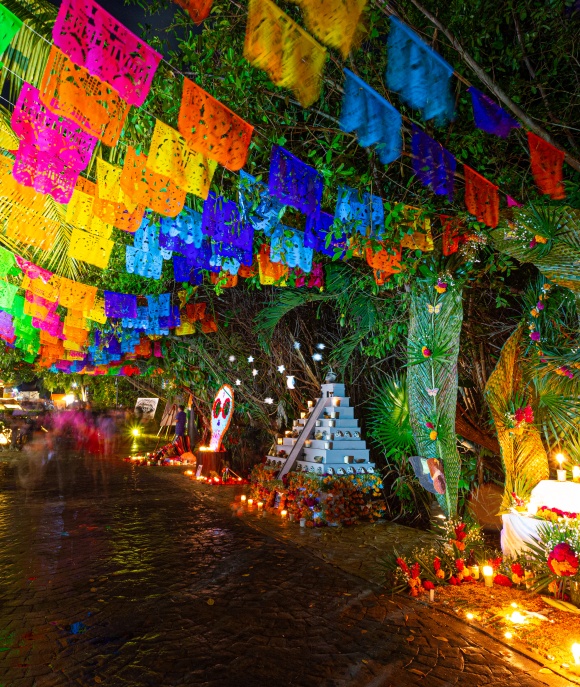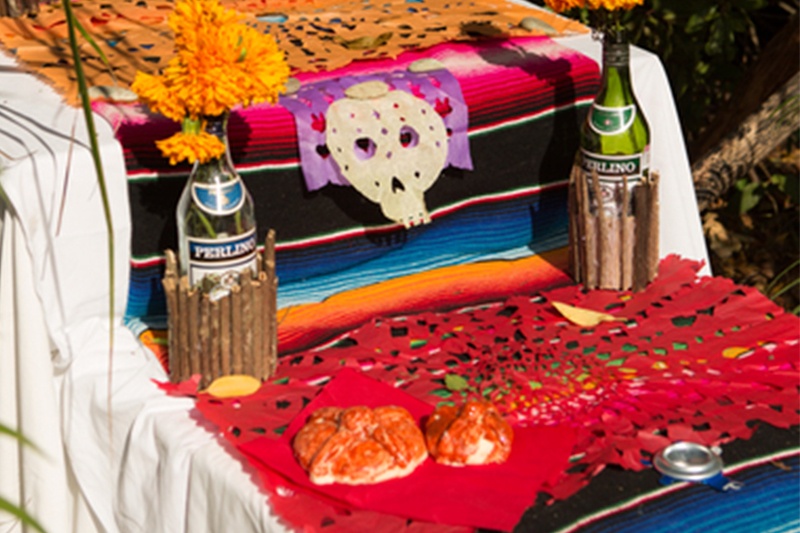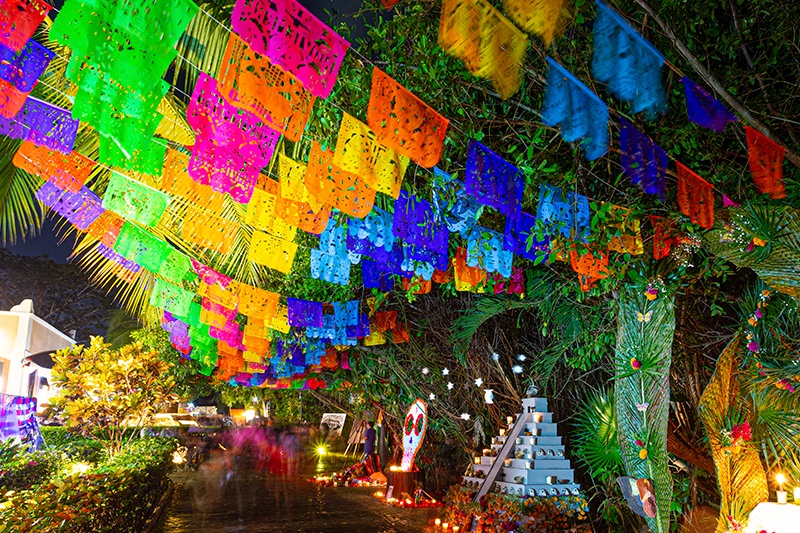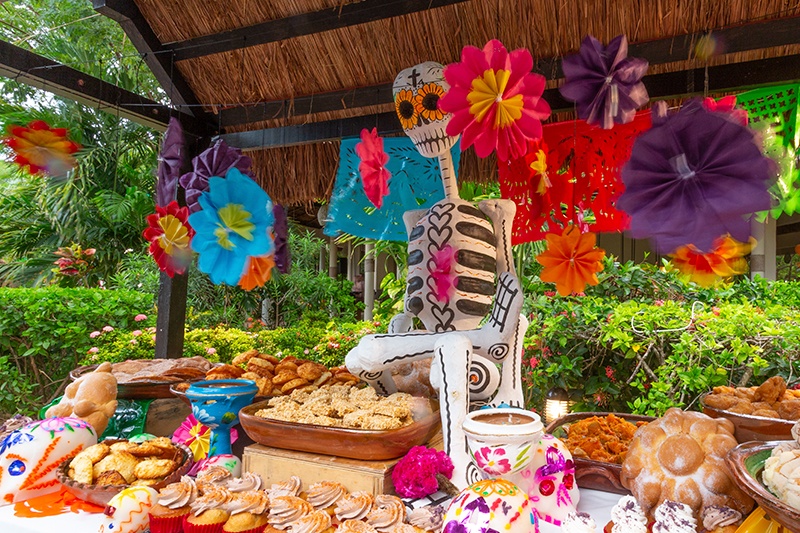
History of Papel Picado
Papel picado is a vibrant and iconic symbol of Mexico's Day of the Dead (Día de los Muertos). These beautiful banners, meticulously crafted by cutting intricate designs into colorful tissue paper, fill homes, cemeteries, and public spaces with joy and festivity, commemorating the lives of loved ones who have passed on. Let's delve into the captivating history, rich symbolism, and how you can craft your own papel picado

One of the many things that give this celebration color and joy is the papel picado, made mainly with multicolored China paper, with themes alluding to death. Other decorations include skulls, catrinas, flowers, animals, plants, and the names of the deceased. Day of the Dead is a time in the year that brings families together to remember the people that they have lost and celebrate their lives instead of mourning them.
History of Papel Picado for the Day of the Dead
Papel picado, meaning "perforated paper" or "pecked paper," is more than just a decorative element; it represents Mexico's rich cultural heritage and deep-rooted beliefs surrounding life, death, and remembrance. These delicate banners, meticulously crafted by hand-cutting intricate designs into colorful tissue paper, are synonymous with the Day of the Dead (Día de los Muertos) celebrations. However, their origins trace back much further, weaving a tale of cultural exchange and artistic evolution.
- Ancient Roots in Pre-Columbian Mexico: Long before the arrival of the Spanish, indigenous civilizations in Mexico were already practicing the art of paper cutting. The Aztecs, in particular, were skilled artisans who utilized a unique type of bark paper known as amate, derived from fig and mulberry trees. They meticulously chiseled intricate figures into this material, often depicting deities, sacred symbols, and scenes from their mythology. These amate creations served ceremonial purposes, adorning temples, homes, and even clothing during rituals and festivals, adding a visual and spiritual dimension to their cultural practices.
- The Spanish Influence and the Birth of Papel Picado: With the arrival of the Spanish in the 16th century, new materials and techniques were introduced to Mexico, including tissue paper, a thinner and more delicate material that lent itself well to intricate cutting. This fusion of indigenous paper-cutting traditions with European artistic influences marked a turning point in the evolution of the craft. With its vibrant colors and flexibility, the newly introduced tissue paper allowed for more elaborate and detailed designs, giving birth to the colorful and ornate papel picado we recognize today.
- San Salvador Huixcolotla: The Cradle of Papel Picado Artistry: The town of San Salvador Huixcolotla in the state of Puebla has earned its reputation as the epicenter of papel picado artistry. This picturesque town boasts a long and rich history of paper-cutting, with families of artisans passing down their skills and knowledge through generations. The papel picado of Huixcolotla is celebrated for its exquisite craftsmanship, intricate patterns, and bold use of color. Artisans in this town dedicate their lives to perfecting their craft, ensuring that the tradition of papel picado remains alive and vibrant.
- Symbolism and Significance in Day of the Dead: During the Day of the Dead, papel picado transcends its decorative function and takes on profound symbolic meaning. The intricate patterns often depict traditional motifs like skulls (calaveras), skeletons (calacas), flowers (especially marigolds or cempasúchil), animals (such as butterflies and hummingbirds), and even personalized elements like the names of deceased loved ones. These symbols are not meant to be macabre or frightening but rather to celebrate the cycle of life and death. The skull, for instance, represents the departed soul, while the marigold flower is believed to guide spirits back to the world of the living with its vibrant color and aroma. Animals like butterflies and hummingbirds are often seen as messengers between the two realms.
The delicate and ephemeral nature of the tissue paper itself symbolizes the fragility of life and the transient nature of our earthly existence. As the papel picado banners sway gently in the breeze, they create a sense of movement and energy, as if the spirits of the departed are dancing among the living.

Papel picado is hung in homes, cemeteries, and public spaces during Day of the Dead, creating a festive and welcoming atmosphere for the returning spirits. This beautiful tradition serves as a poignant reminder of the enduring connection between the living and the dead, emphasizing the importance of honoring our ancestors and celebrating their lives.
Common Decorations for Day of the Dead Papel Picado
As the Day of the Dead approaches, bustling markets across Mexico transform into a kaleidoscope of colors and patterns. Among the most enchanting decorations are the papel picado banners, their intricate designs dancing in the wind, creating a festive and celebratory atmosphere.
- Skulls (Calaveras): Not a symbol of morbidity, but rather a playful representation of life and death, skulls are a common motif in papel picado. Often adorned with flowers, intricate patterns, and vibrant colors, these calaveras symbolize the acceptance and celebration of mortality.
- Elegant Skeletons (Catrinas): The iconic La Catrina, with her wide-brimmed hat and elegant attire, is a beloved figure in Mexican folklore and a popular papel picado design. She represents the elegance and sophistication of death, a reminder that even in the afterlife, beauty and grace persist.
- Vibrant Marigold Flowers (Cempasúchil): These golden-orange flowers, also known as the "flower of the dead," are believed to guide the spirits of loved ones back home during Day of the Dead. Their vibrant color and strong scent symbolize the warmth and love that connect the living and the departed.
- Animals, Plants, and Nature: Papel picado often features depictions of animals like butterflies, hummingbirds, and dogs, believed to be spirit guides for the deceased. Additionally, images of plants and natural elements symbolize the cycle of life, death, and rebirth.
- Names of Deceased Loved Ones: Personalized papel picado banners often include the names of family members and friends who have passed away. This serves as a touching tribute, ensuring their memory lives on in the hearts of the living.

The delicate and ephemeral nature of the tissue paper used in papel picado serves as a poignant reminder of the fragility of life. As the banners sway gently in the breeze, they seem to whisper the stories of those who are no longer with us. Each cut and pattern represents a memory, a shared experience, a life lived to the fullest. Papel picado not only decorates the physical space but also weaves together a tapestry of life and remembrance, connecting generations and honoring the rich cultural heritage of Mexico.
Crafting Your Own Papel Picado
Want to add a personal touch to your Day of the Dead celebration? Creating your papel picado is a fun and rewarding way to connect with this vibrant tradition. It's a simple craft that can be enjoyed by people of all ages, and the results are always stunning.
Materials You'll Need:
- Colorful tissue paper (papel de china): The more vibrant the colors, the more festive your papel picado will be.
- Cardboard: This will serve as your stencil.
- Scissors: For cutting the tissue paper.
- Pencil: For sketching your design on the cardboard.
- Glue stick or white glue: Attach the tissue paper flags to the thread.
- Thread or string: To create the banner.
- Craft knife (for adults only): This is used to cut out the design from the cardboard stencil.
Step-by-Step Instructions:
- Design Your Stencil: Fold your cardboard in half. On one side, sketch your desired design. You can find inspiration online or in books or create your unique patterns. Common motifs include skulls, skeletons, flowers, animals, and geometric shapes.
- Cut Out Your Stencil: Carefully cut out your design using the craft knife (adults only). Keep the cardboard folded so that you create a symmetrical design on both sides.
- Prepare the Tissue Paper: Fold several sheets of tissue paper together, matching the fold of your cardboard stencil. You can use multiple colors of tissue paper to create a more vibrant banner.
- Trace and Cut: Place the stencil on the folded tissue paper. Use a pencil to trace the design onto the top layer of tissue paper. Then, use scissors to carefully cut out the design, ensuring all tissue paper layers are cut through.
- Create Your Banner: Cut a length of thread or string to the desired length of your banner. Unfold your cut tissue paper and gently separate the layers. Apply a small amount of glue to the top edge of each flag and attach it to the thread, spacing them evenly apart.
- Hang and Admire: Your papel picado banner is ready to hang once the glue has dried! Display it in your home, on an altar, or at a Day of the Dead celebration.
Tips and Tricks:
- If you're new to papel picado, start with simple designs and gradually work up to more intricate patterns.
- Experiment with different colors of tissue paper to create various looks.
- Use a hole punch to create decorative edges on your flags.
- Get creative with your designs! There are no rules when it comes to papel picado.
Crafting your own papel picado is a fun and easy way to add a touch of Mexican culture to your Day of the Dead celebration. With a little creativity and patience, you can create beautiful banners that will be cherished for years to come.
A Special Day of the Dead Papel Picado
To fully immerse yourself in the beauty and traditions of the Day of the Dead, visit Sandos Caracol Eco Resort in Mexico. We offer a unique celebration that honors this special occasion. Guests can witness:
- Traditional Gastronomy: Savor pan de muerto (bread of the dead), mole, and other delicious Mexican dishes and sweets.
- Costume Parade: Witness a vibrant parade of catrinas, skeletons, and other festive costumes.
- Altars and Offerings (Ofrendas): See beautifully decorated altars honoring deceased loved ones.
- Live Music: Enjoy the sounds of mariachi, cumbia, and other traditional Mexican music.
Join us at Sandos Caracol for an unforgettable Day of the Dead experience that celebrates life, remembrance, and the rich cultural heritage of Mexico!
